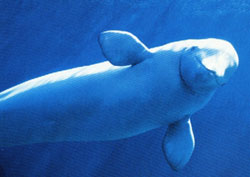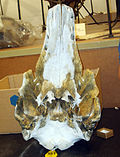Monodontidae
Monodontidae is a small group of toothed whales with two species: the narwhal (Monodon monoceros) and the beluga (Delphinapterus leucas). These marine mammals are known for their unique characteristics, distribution, and importance in nature.[1][2][3][4]
| Monodontidae | |
|---|---|

| |
| Beluga whale | |
| Scientific classification | |
| Kingdom: | Animalia |
| Phylum: | Chordata |
| Order: | Artiodactyla |
| Superfamily: | Delphinoidea |
| Family: | Monodontidae J. E. Gray, 1821 |
| Type genus | |
| Monodon C. Linnaeus, 1758
| |
| Extant genera | |
Classification
Monodontidae is in the Cetacea order, which includes all whales, dolphins, and porpoises. It's part of the toothed whale suborder Odontoceti, specifically in the superfamily Delphinoidea. Monodontidae shares this category with other families like Delphinidae (oceanic dolphins) and Phocoenidae (porpoises).[3][4]
Physical Traits
Narwhal
Narwhals have a tusk, a long tooth growing up to 10 feet (~3 meters) long, mainly seen in males. Female tusks are smaller and cone-shaped. They have spotted gray/brown skin for camouflage and are medium-sized, about 13 to 18 feet (4 to 5.4 meters) long.[4][5]
Beluga
Identified by their white color and round forehead or melon. They lack dorsal fins, helping in icy waters. Belugas reach 13 to 20 feet (4 to 6 meters) long, with males usually being larger. [3][6][7]
Habitat
Narwhals and belugas live in the Arctic and subarctic regions of the northern hemisphere. Narwhals inhabit the Canadian Arctic, Greenland, and Russian waters. Belugas have a wider range from the Arctic Ocean to subarctic regions like the Bering Sea and the Gulf of St. Lawrence. [3][4][6][7][8]
Behavior
Both species are social and vocal. Belugas are famous for varied vocalizations like clicks, whistles, and other sounds, important for communication and navigation in their often dark habitats. They prefer shallow coastal waters and migrate based on ice and prey changes.[3][4][7][8]
Diet
Monodontids feed on fish, squid, and crustaceans, adapted to their cold-water homes. They use echolocation (high-frequency clicks that bounce off objects) to locate prey by echo, detecting prey size, shape, and location.[3][4][7]
Conservation
IUCN lists narwhals and belugas as least concern, but climate change and habitat loss are potential threats. Shrinking Arctic ice due to warming affects ice-covered hunting/resting areas. Human activities like shipping and resource extraction generate noise pollution, impacting their communication and navigation.[3][4][7][8]
Monodontidae Media
References
- ↑ Myers, Phil. "Monodontidae (beluga and narwhal)". Animal Diversity Web. Retrieved 2023-08-20.
- ↑ "Monodontidae | mammal family | Britannica". www.britannica.com. Retrieved 2023-08-20.
- ↑ 3.0 3.1 3.2 3.3 3.4 3.5 3.6 "Beluga | Habitat, Diet, & Facts | Britannica". www.britannica.com. 2023-08-16. Retrieved 2023-08-20.
- ↑ 4.0 4.1 4.2 4.3 4.4 4.5 4.6 "Narwhal | Habitat, Tusk, & Facts | Britannica". www.britannica.com. 2023-08-09. Retrieved 2023-08-20.
- ↑ "Narwhal, facts and photos". Animals. 2010-11-11. Retrieved 2023-08-20.
- ↑ 6.0 6.1 "Beluga Whale". Animals. 2014-03-01. Retrieved 2023-08-20.
- ↑ 7.0 7.1 7.2 7.3 7.4 "Beluga Whales ~ MarineBio Conservation Society". Retrieved 2023-08-20.
- ↑ 8.0 8.1 8.2 "Beluga - Animals Affected by Climate Change". www.theglobaleducationproject.org. Retrieved 2023-08-20.
